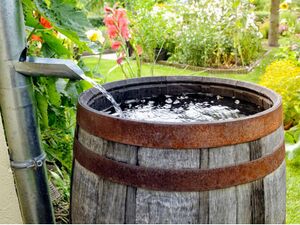Water

Water is the most common liquid on Earth and is comprised of hydrogen and oxygen. It falls from the clouds in the sky and forms lakes, rivers, and oceans where it evaporates back into clouds. It is essential to plants and animals, but many people and regions of the world do not have sufficient access to clean water.
When water quickly runs over the land it doesn't have sufficient time to be absorbed into the soil. Instead it can cause erosion as it races over and carries off any accumulated topsoil, organic matter, and silt. Fast moving water can also create undesirable crevasses and gullies. Swales help to slow water to allow it to be absorbed into the soil to recharge groundwater.
Collect water at a higher elevation than a structure if possible to allow gravity, rather than a pump, to direct its flow.[1] If necessary, ram pump can be used to move water from one elevation to higher one without the need of electricity. Water can also provide and store energy.
An aquatic growing condition is one where plants are growing in standing water. Hydric growing conditions have soil that is seasonally wet but without standing water. Mesic has a moderate amount of moisture and may need supplemental water when conditions are especially dry. Xeric growing conditions is very dry and desert like.
Water can contain dissolved minerals in it. The type of amount can impact its taste and its properties and can be described by its water hardness level.
Collection
Water can be collected in a well and by rainwater harvesting.
References
- ↑ Mollison, Bill. Introduction to Permaculture. Tagari Publications, 2011. p 5.